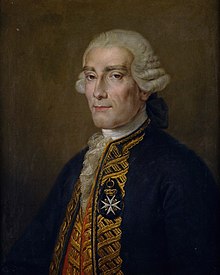Jorge Juan y Santacilia

Jorge Juan y Santacilia (January 5, 1713 – June 21, 1773) was a Spanish mathematician, scientist, naval officer, and mariner.
Family and Education
Jorge Juan was born on the estate El Fondonet, the property of his grandfather don Cipriano Juan Vergarain in Novelda, Alicante, Spain. He was baptised in the Church at Monforte del Cid. Juan was born of two distinguished families: his father was don Bernardo Juan y Canicia who came from the branch of the Counts of Peñalba, and his mother was doña Violante Santacilia y Soler de Cornellá, who came from prominent land-owning family in Elche. Both of his parents were widowed and remarried. They lived in their house on the Plaza del Mar in Alicante and only vacationed in Novelda.
His father died when Juan was only three years old and under the care of the Jesuits of the Jesuit school in Alicante. His uncle don Antonio Juan, a Canon at the Collegiate Church took charge of young Jorge and continued his education. Later another uncle, don Cipriano Juan, a Knight of the Order of Malta, took charge of his education and sent him to Saragossa for a preparatory education for higher studies.
At the age of 12 he was sent to Malta to receive Holy Orders at the Order of Malta. The next year he became page to the Grand Master don Antonio Manuel de Villena, who granted him the title of Commander of Aliaga in Aragón. Thus he received his first title when he was only 14. Soon he became a Knight of the Order of Malta, which implied life-long celibacy.
In 1729, when he was 16, he returned to Spain and applied for entry to the Royal Company of Marine Guards, the Spanish military school for naval officers. He entered the academy in 1730 and studied modern technical and scientific studies subjects such as geometry, trigonometry, astronomy, navigation, hydrography, and cartography. He also completed his education in the humanities with classes in drawing, music and dancing. He earned the reputation of being an outstanding student and his fellow students called him Euclid. He finished his studies at the academy in 1734. At the young age of 22 he was given command of a corvette and he participated in the expedition against Orán and the campaign of Naples.
Career

In 1734, King Philip V of Spain asked Jorge Juan and fellow scientist Antonio de Ulloa to join the French Geodesic Mission organized by the French Academy of Sciences from Paris, under command of Charles de La Condamine. The mission was to measure the length of a degree of the longitudinal meridian at the Equator in South America and to determine the roundness of the Earth. On May 26, 1735 they left Cadiz in the company of the Marquess of Villagarcía, who had just been appointed Viceroy of Peru. Jorge Juan was on board the ship El Conquistador and Antonio de Ulloa on the frigate Incendio. The expedition traveled to Quito in present-day Ecuador and after nine years of careful study, determined that the Earth is not perfectly spherical but is oblate, i.e. flattened at the poles. Juan also successfully measured the heights of the mountains of the Andes using a barometer.
Juan remained nine years in America, studying the political and social situation of the Spanish territories. On his return to Spain, King Ferdinand promoted him to captain.
The Marques de la Ensenada ordered Juan to travel to England secretly to study new naval construction methods and armament of the English. In 1749 he traveled incognito under the name of Mr. Josues and learned all that he could from the English, and brought back British naval constructors. In an ironic twist, many of them (including Matthew Mullan and Richard Rooth) went on to build the Spanish ships that would later fight in the battle of Trafalgar. On his return to Spain in 1750 he was placed in charge of Spanish naval construction and improving the shipyards and armaments.
On 1757 he founded the National Astronomical Observatory of Spain Observatorio Astronómico Nacional de España.
He died in Madrid in 1773 at the age of 60. His reported symptoms, including muscle stiffness and seizures, were almost certainly the result of a cerebral amebic infection. He was buried in the church of San Martín.
Works
- Compendio de navegación (1757)
- Examen marítimo teórico-práctico ((1771)
- Estado de la astronomía en Europa (1774)
In collaboration with Antonio de Ulloa
- Plan del camino de Quito al río Esmeraldas, según las observaciones astronómicas de Jorge Juan y Antonio de Ulloa (1736-1742)
- Observaciones astronómicas y físicas hechas en los Reinos del Perú (Madrid, 1748)
- Relación histórica del viaje hecho de orden de su Majestad a la América Meridional (Madrid, 1748)
- Disertación Histórica y Geográfica sobre el Meridiano de Demarcación entre los dominios de España y Portugal (1749)
- Noticias Secretas de América, sobre el estado naval, militar y político del Perú y provincia de Quito (The Secret news of America, on the naval state, military and political of the Peru and province of Quito) (1748) (published in London 1826 after publication was banned by the Spanish government)
